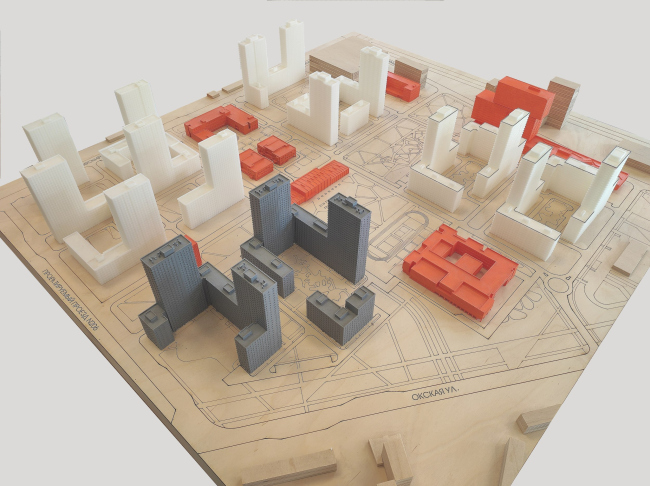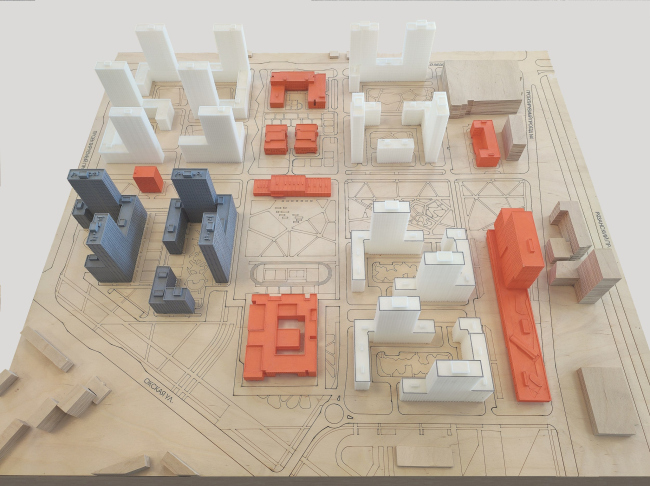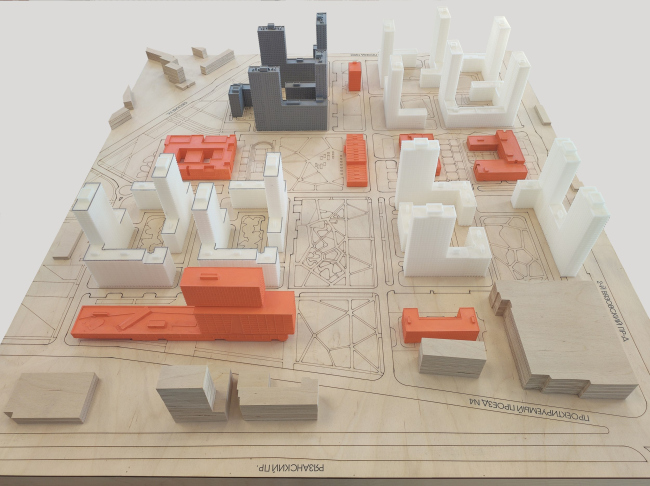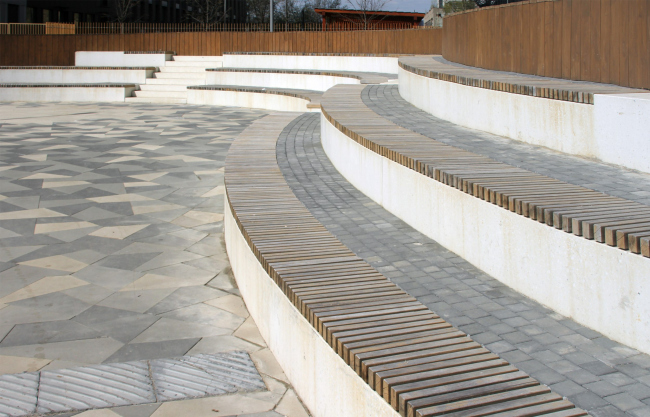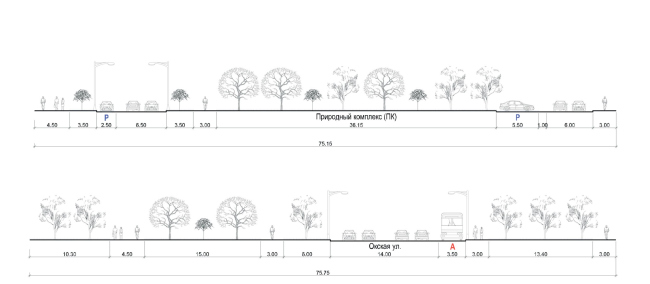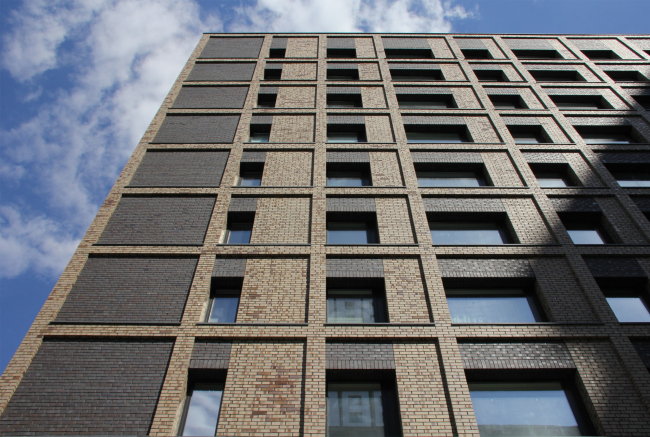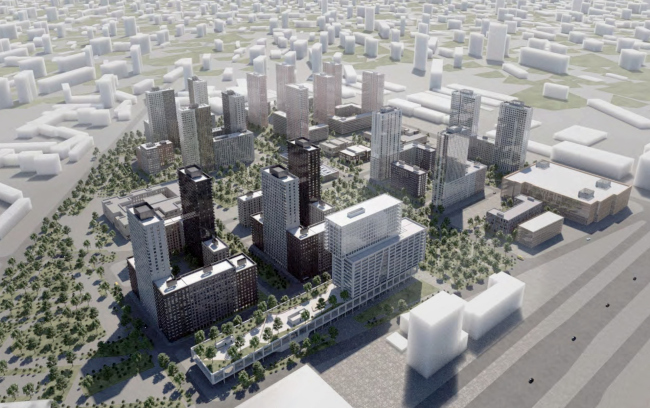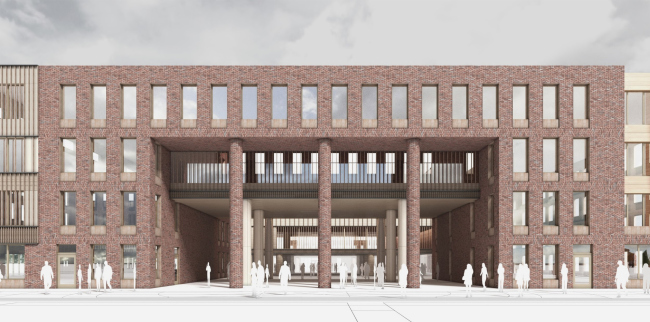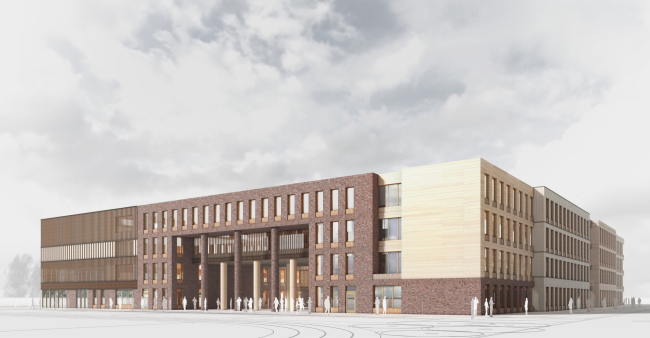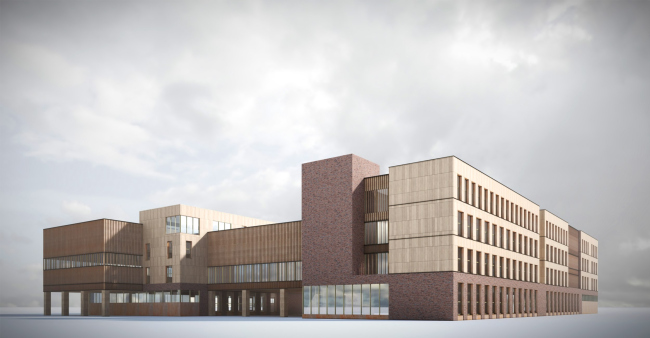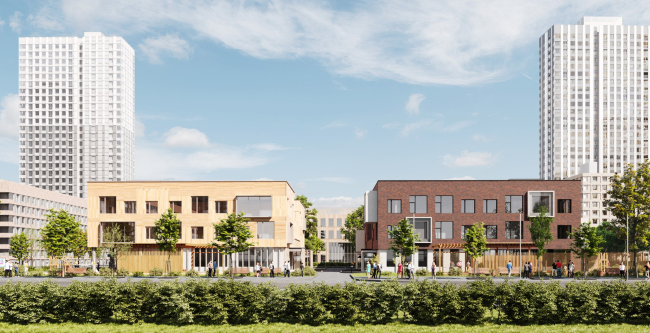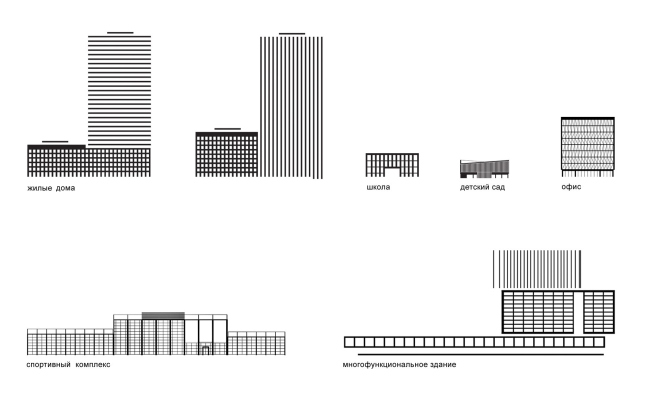|
Published on Archi.ru (https://archi.ru) |
|
| 10.05.2023 | |
|
A Balanced Solution |
|
|
Julia Tarabarina |
|
| Architect: | |
| Alexsey Ginzburg | |
| Studio: | |
| GA | |
|
The residential complex “Balance” on Moscow’s Ryazansky Prospekt is one of the large-scale, and relatively economical (again, by Moscow standards) housing projects. Its first phase has already been built and landscaped; the work on the others is in progress. Nevertheless, it has an integral internal logic, which is based on the balance of functions, height, and even image and space composition. The proposed solutions are recognizable and laconic, so that each of them was reduced by the authors to a graphic “logo”. To see everything, you have to flip through the pages and look through to the end. The Balance residential complex is being built next to the Okskaya subway station of the Nekrasovskaya line, between Ryazansky Prospekt and Okskaya Street. If you look broadly, on one side there is the Kuskovo Park, and on the other side Kuzminki. If you look closer, the area consists mostly of blocks of five-story buildings from the late 1950s to the 1960s, buried in wild greenery, and the whole scene already looks almost like a park. The district, however, is actively being built up on a new scale – on the opposite side of Ryazansky Prospect, the Residential Complex “Mikhailovsky Park”, designed in the recognizable style of the PIK developers, is almost completed. To the north-west of the site of Balance, there is a large industrial park with a railroad line that is no longer in operation. The Balance complex. A modelCopyright: © Ginzburg ArchitectsThe task, as we can see, is clear enough; the area is not the most expensive, but it has its strong points. The apartments were supposed to be mostly small, although there are two – and three-bedroom apartments, the “slicing” of space was to be relatively fractional – the complex is designed for young people.  Alexsey Ginzburg Our client asked us to design a “city for millennials”, suitable for this location and designed for the target audience of young buyers, people whose real estate requirements differ from those of the older generation. They buy housing not as an investment, but as a utilitarian function, yet, on the other hand, they are more demanding in terms of services available to them. Accordingly, apartments here are small, but they have large windows; there is all the basic necessary infrastructure: a health center, two schools, a shopping center, two office buildings, boulevards, and, finally, rental space in the first floors. Of course, I wouldn’t go as far as to call it a special “house for XXI century people”, but our concept provides everything that the standard of Moscow construction of the last ten years or so requires. 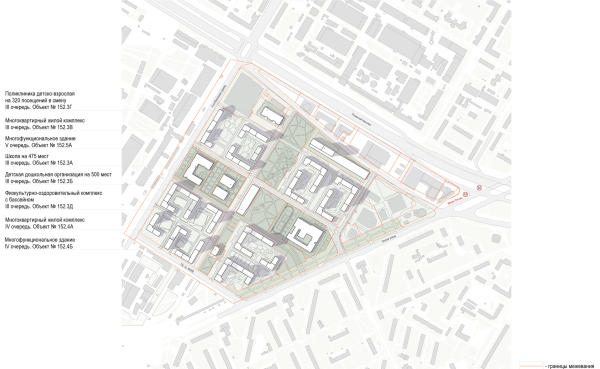 The Balance complex. The master planCopyright: © Ginzburg Architects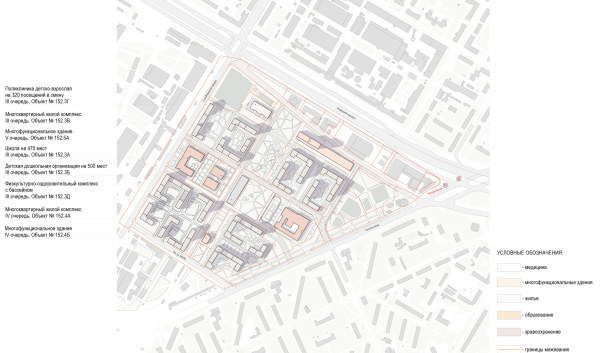 The Balance complex. The functional zonesCopyright: © Ginzburg ArchitectsThe layout of the complex is, above all, the result of a set of requirements and constraints. However, it has an internal logic, rhythm, and rules. Wide boulevards divide the city blocks into four groups crosswise, almost symmetrically. The one that goes along the center of the complex parallel to Ryazansky Prospekt unites two schools and two kindergartens. The second boulevard begins from Ryazansky Prospekt, its north-eastern part is wider, and its south-western part is narrower, because from this side the Okskaya street cuts off diagonally part of the territory. Along the avenue, before the second boulevard starts, there is a health center on the right and a multifunctional building on the left combining a shopping center in the lower part, offices in the central part and apartments in the upper part (all the other apartments of the complex are residential). On the western narrow part of the boulevard, there is another smaller office building. At the crossroads of the boulevards there is a Sports and Recreation Center with a swimming pool. The Balance complex. A modelCopyright: © Ginzburg ArchitectsThe Balance complex. A modelCopyright: © Ginzburg ArchitectsNow the construction and landscaping design of the first stage is completed, as well as two blocks in the southern quadrant; they are separated by an internal street, which is also a small boulevard and begins with an amphitheater, behind which is the site of a built-in first-floor preschool. The ground-floor rental space is gradually being populated; the Buchanka discounter has already opened. The fences separating the courtyards look very nice – they are relatively low and consist of thin wooden slats. The Balance complex. Phase 1Copyright: Photograph © Julia Tarabarina, Archi.ru, 2023The Balance complex. Phase 1Copyright: Photograph © Julia Tarabarina, Archi.ru, 2023Section view street-wise. The Balance complexCopyright: © Ginzburg ArchitectsAccording to Aleksey Ginzburg, the next city blocks – and the architects are now working on the “project” phase of the second stage – will look slightly different, but the basic principles will remain the same. The blocks consist of medium-rise sections, from 7 to 11 floors high, forming a semi-closed contour of large yards. These mid-rise houses are brick, executed in various shades, but with rather simple facades: they use wainscoting, a relief grid, inserts of a different color, and bricks with enamel flecks, no more than that; they do not look mottled at all. The Balance complex. Phase 1Copyright: Photograph © Julia Tarabarina, Archi.ru, 2023The other part of the same contour is composed of towers of extended configuration, their height of 30 floors corresponds to the height limit of 100 meters – and the facades, in contrast to the prevailing brick contour in the lower part, are aluminum. In Phase 1, each tower is divided into a black half with golden verticals and a silver half with aluminum surfaces, with the metal appearing rather light gray in cloudy weather and white in sunny weather, especially from a distance. Some of the towers grow aluminum right from the ground, separating the horizontal structure, some of them turn out to be metal only above the brick floors and thus maintain their predominance in the middle part of the story. 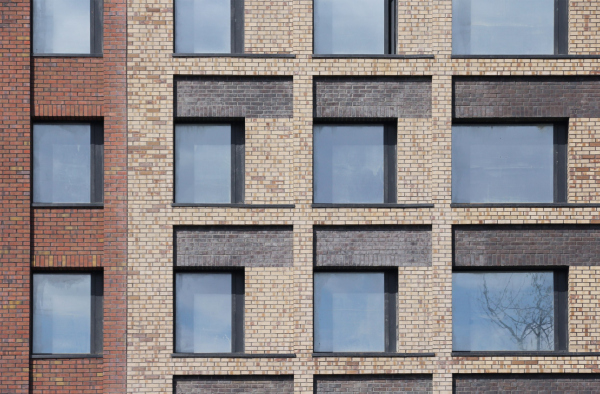 The brick facade. The Balance complex. Phase 1Copyright: Photograph © Julia Tarabarina, Archi.ru, 2023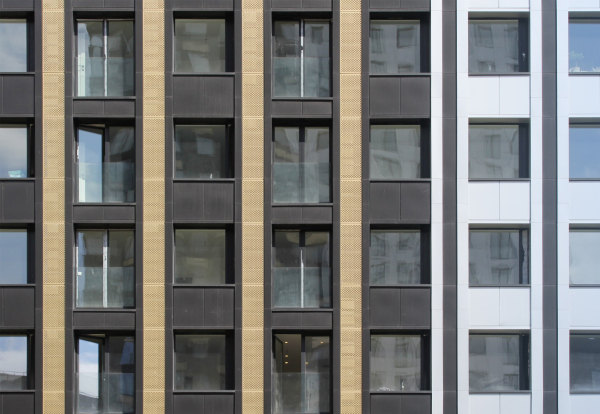 The aluminum facade. The Balance complex. Phase 1Copyright: Photograph © Julia Tarabarina, Archi.ru, 2023The volumes of the two types – mid-rise brick ones and high-rise aluminum ones – are distributed in a ratio of about 30 to 70: the mid-rise takes up two-thirds of the contour, the high-rise one-third, and, accordingly, the thirty-rise takes up two-thirds of the entire height. Thus, in addition to the balance of functional content, there is a balance of volumetric construction, unassuming, but clear and easy to read. Probably, this could be the clue to the name of the complex. 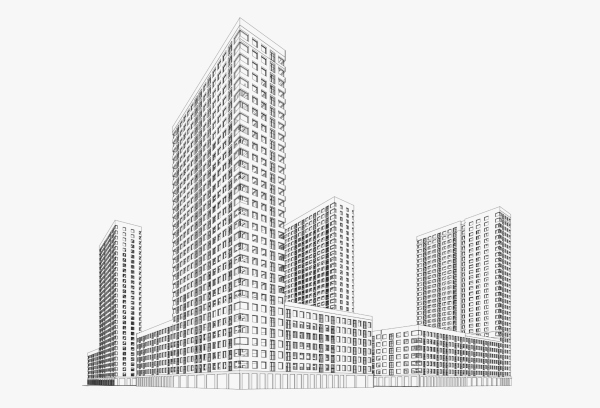 The Balance complex. Phase 4Copyright: © Ginzburg Architects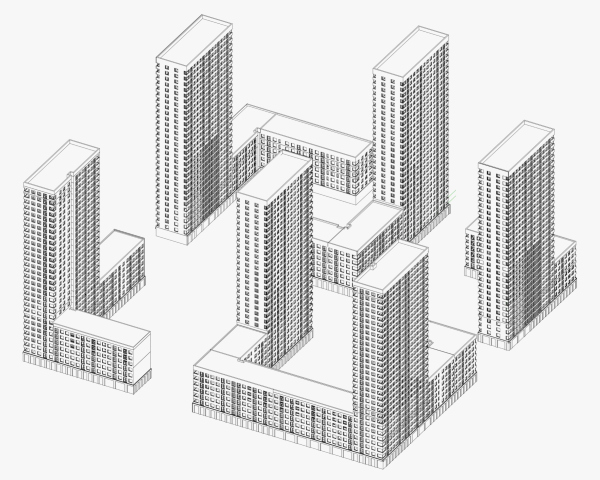 The Balance complex. Phase 4Copyright: © Ginzburg Architects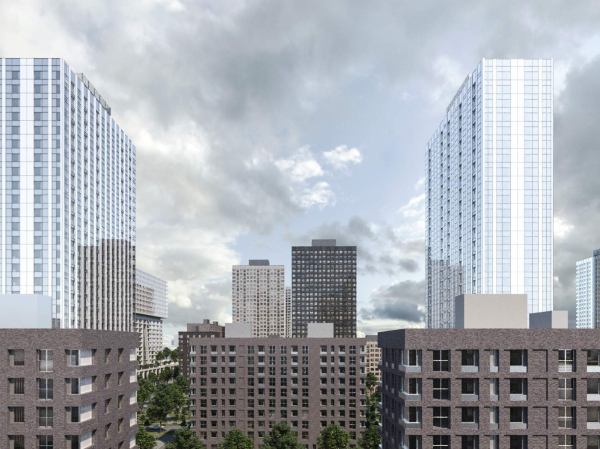 The Balance complex. Phase 3, Version 1Copyright: © Ginzburg Architects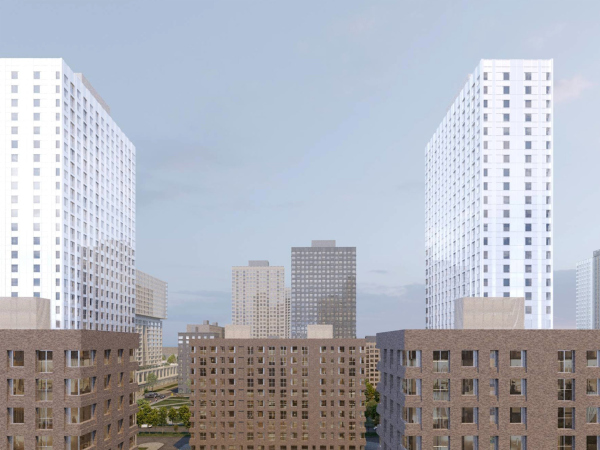 The Balance complex. Phase 3, Vesrion 1Copyright: © Ginzburg ArchitectsThe same principle will be applied to the other city blocks: brick as a more cozy and tactile material closer to the ground, aluminum, more technical and modern, closer to the sky. An urban space should appear below, with stores and cafes, and with facades lined up along the front of the red lines. 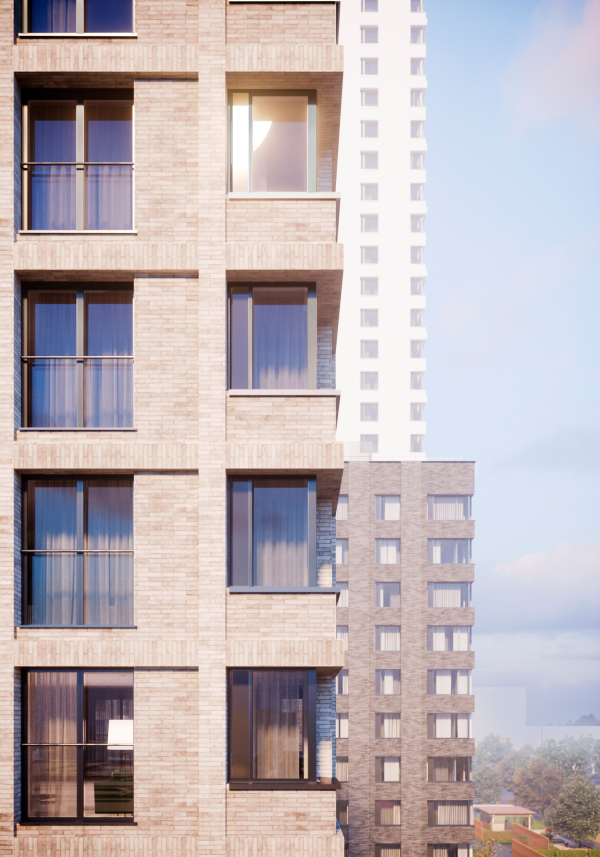 The Balance complexCopyright: © Ginzburg Architects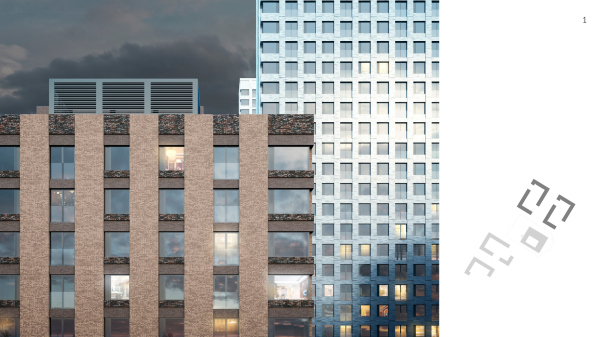 The Balance complexCopyright: © Ginzburg Architects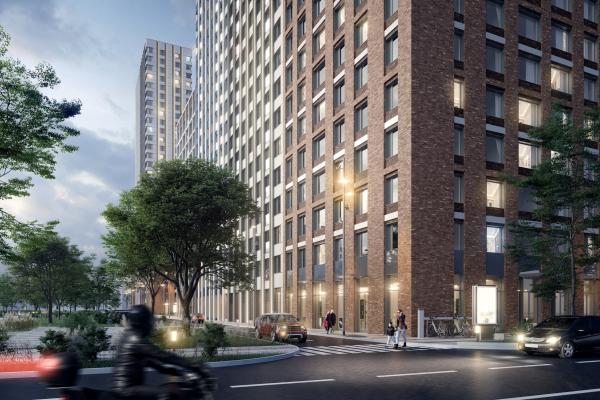 The Balance complexCopyright: © Ginzburg Architects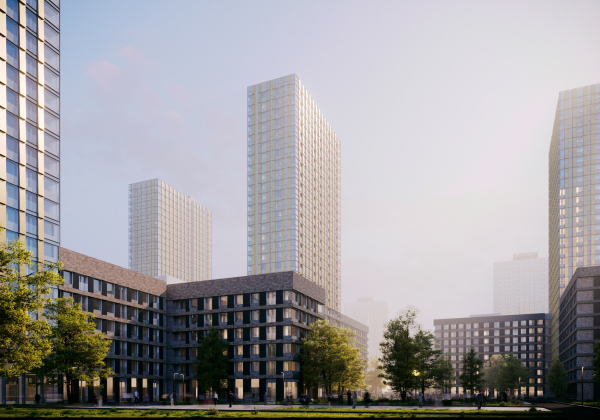 The Balance complexCopyright: © Ginzburg Architects The Balance complexCopyright: © Ginzburg Architects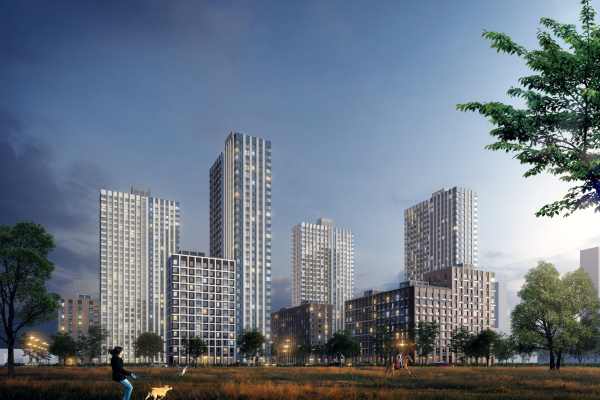 The Balance complexCopyright: © Ginzburg Architects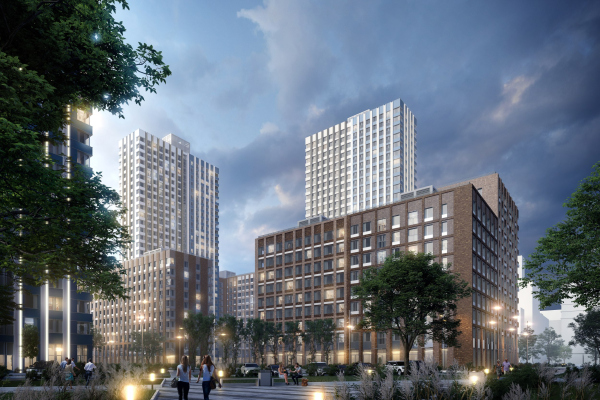 The Balance complexCopyright: © Ginzburg Architects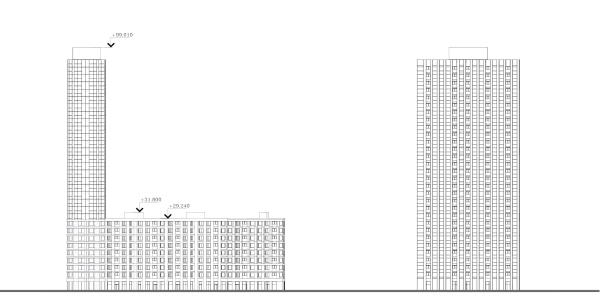 The facades of the resodential blocks of Phase 1. The Balance complexCopyright: © Ginzburg Architects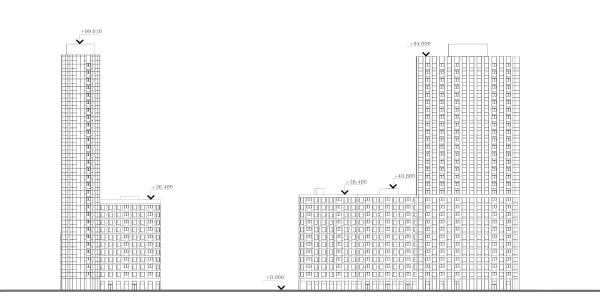 The facades of the resodential blocks of Phase 1. The Balance complexCopyright: © Ginzburg Architects The Balance complexCopyright: © Ginzburg ArchitectsThe blocks are planned flexibly – somewhere there are two courtyards, somewhere there are four. However, the grid is generally diagonal, echoing the intersection of the boulevards. All the towers are of the same optimal parameters – single-section, but long enough. The architects have arranged them for each “square” in their own rhythm: in the south and north corner the towers are perpendicular to each other; in the west and east they are parallel, stretching from northeast to southwest. Thus, with a general approach, a large pattern emerges; it will be possible to fully appreciate it, apparently, only from a drone, and at the same time it forms a kind of intuitively-grasped variety of rhythm. The Balance complex. Phase 4, Version 1Copyright: © Ginzburg ArchitectsThe Balance complex. Phase 4Copyright: © Ginzburg ArchitectsThe Balance complexCopyright: © Ginzburg Architects The Balance complexCopyright: © Ginzburg Architects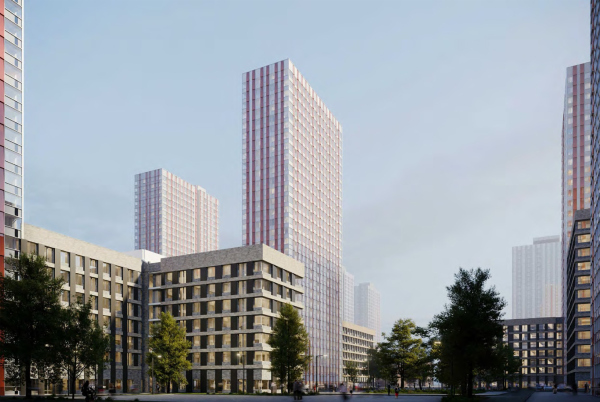 The Balance complexCopyright: © Ginzburg ArchitectsCurrently, the architects are working on the design of Phase 2, which includes one of the two schools, a large one with a capacity of 1,250 students. The school particularly fascinated me. The façades are dominated by brick, designed to unite the building with the lower front of the residential buildings into a single terracotta urban belt. The plan is rectangular, simple, but it sports an open courtyard, along the lines of the “cloister” in the spirit of classical English schools. Thin high columns of the entrance loggia – ones of a round section and coated with brick – balance on the verge of portico and Corbusian piers, subliminally reminding of the ancient origins of schooling per se. The school for The 1250 students. The Balance complexCopyright: © Ginzburg Architects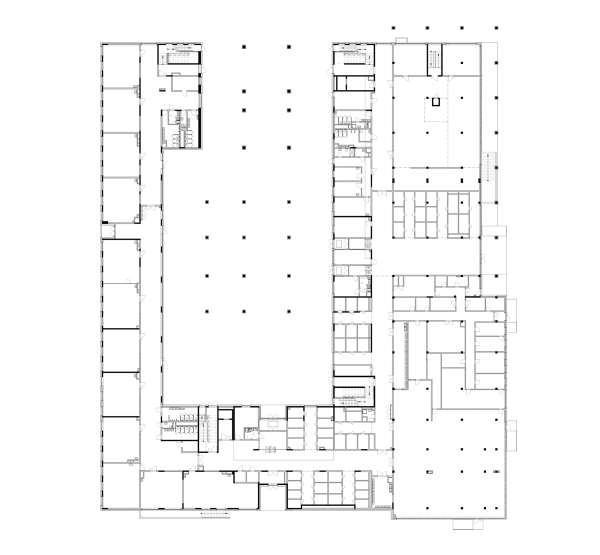 The school for The 1250 students. Plan on the first-floor level. The Balance complexCopyright: © Ginzburg Architects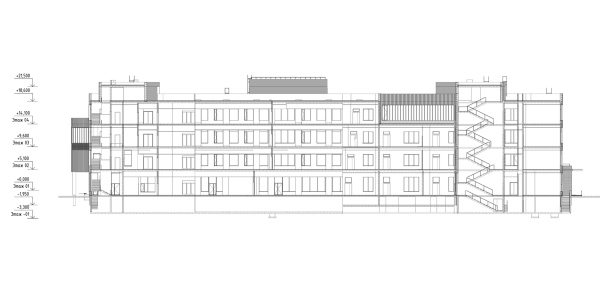 The school for The 1250 students. Section view. The Balance complex. Section view. The Balance complexCopyright: © Ginzburg ArchitectsAnother peculiar feature of the school is that the typology of its inner premises is turned outwards. For example, classrooms with windows are coated with bricks, other volumes are faced with wood-imitating panels, and the gym is decorated with “wooden” lamellas, whose task is to lighten up the facade and reveal its function on the outside, justifying the image solution with its inner structure. The school for The 1250 students. The Balance complexCopyright: © Ginzburg ArchitectsThe school for The 1250 students. The Balance complexCopyright: © Ginzburg ArchitectsThe same applies to the second school, located on the opposite “pole” of the boulevard – it combines brick surfaces with wooden ones, justifying the facade solutions with function. But the building is smaller, designed for 475 students, and its plan is a square, open to the center. At this point in the concept, there are two options, the lighter and the darker ones. 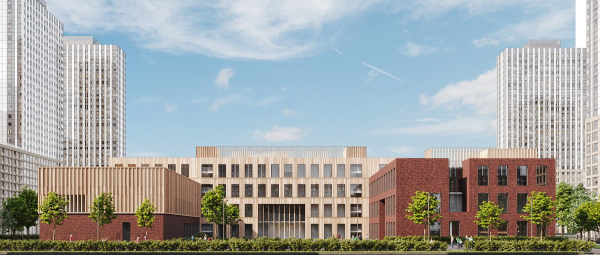 School #145. The Balance complexCopyright: © Ginzburg Architects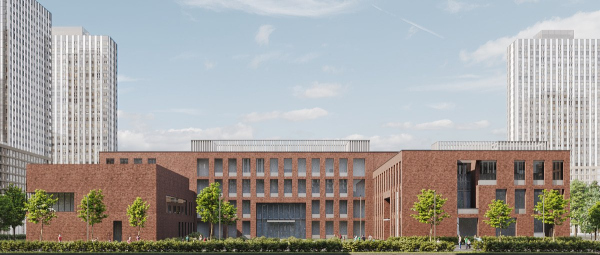 The Balance complex. School #145Copyright: © Ginzburg ArchitectsTwo similar, mirror-image buildings for preschools are adjacent to the “small” school. Their facades are also brick, and the functional validity concerns the arrangement of the windows: large ones in the playrooms and smaller ones in the bedrooms. The architects explain the light tone of the brick of one building and the dark tone of the other as “dark and white chocolate”. The Balance complex. The kindergartenCopyright: © Ginzburg ArchitectsInitially, the architects had a different vision of the kindergarten buildings: with glass facades and vertical “wooden” ribs, echoing the neighboring Sports and Recreation Center, but eventually the “chocolate” version of buildings for preschools prevailed. The Balance complex. The kindergartenCopyright: © Ginzburg ArchitectsThe Sports and Recreation Center and office buildings, on the other hand, are emphatically modern, different from the brick surroundings, and complement the double matter of the residential buildings with a kind of a “third” one. The sports complex sprawls on the ground; it stretches along the axis of the boulevard coming from the avenue, but it is somewhat displaced from this axis so as not to block the perspective. Ginzburg architects made its facades glassy, with wood-colored ribs – the goal was to minimize the volume for the view from the other, transverse boulevard, to make it as transparent as possible, so that the building would not become a heavy obstacle. On the other hand, the pool and the halls inside will receive maximum light thanks to this solution, and in the evenings in the center of the complex a cozy glow of the building is provided, open to all and, thus, encouraging residents to engage in a healthy lifestyle. 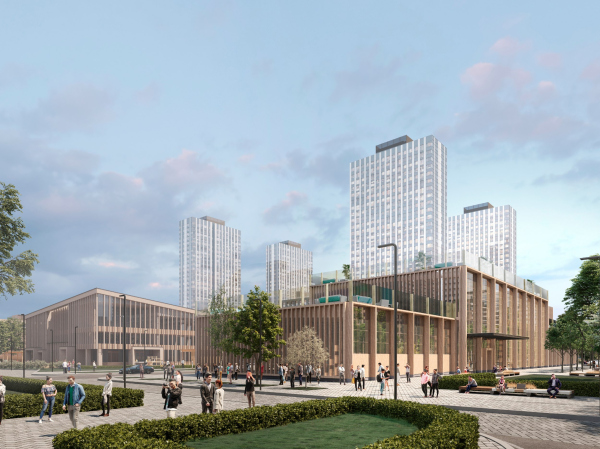 The Balance complex. The Sports and Recreation CenterCopyright: © Ginzburg Architects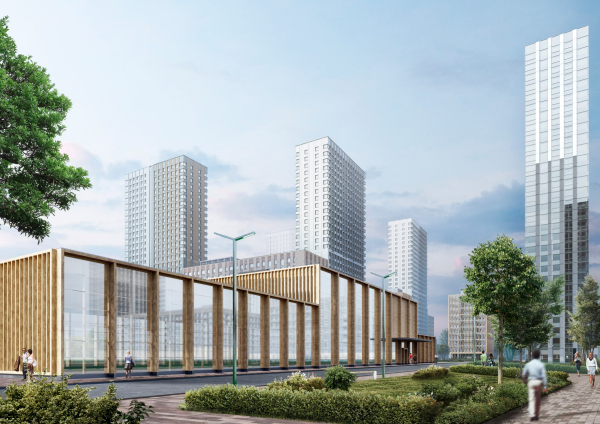 The Balance complex. The Sports and Recreation CenterCopyright: © Ginzburg Architects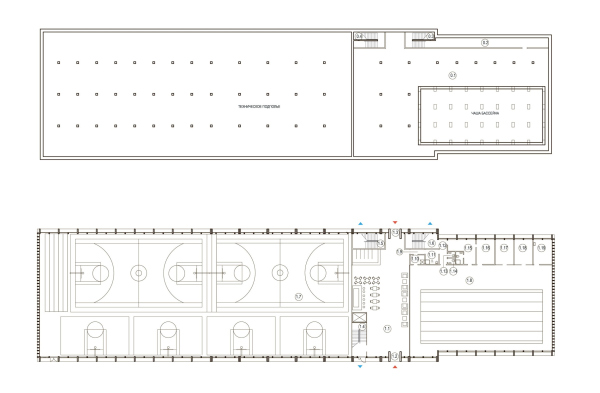 The Sports and Recreation center. The Balance complexCopyright: © Ginzburg Architects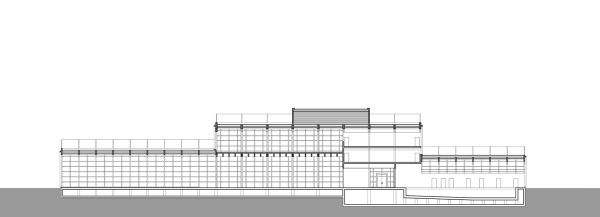 The Sports and Recreation Center, a cross-section view. The Balance complexCopyright: © Ginzburg ArchitectsThe architects propose to make the roofs of the schools, kindergarten, and the Sports Center green for the sake of the “fifth façade”, and maybe even make them operational – although there is still a long way to go before this solution is implemented and probably even discussed. The small office building echoes the Sports and Recreation Center with its simple and transparent facades, only with diagonals added to the vertical ribs. 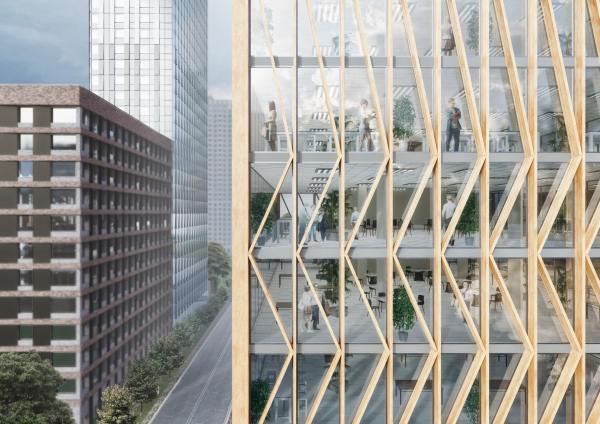 The Balance complex. The multifunctional buildingCopyright: © Ginzburg Architects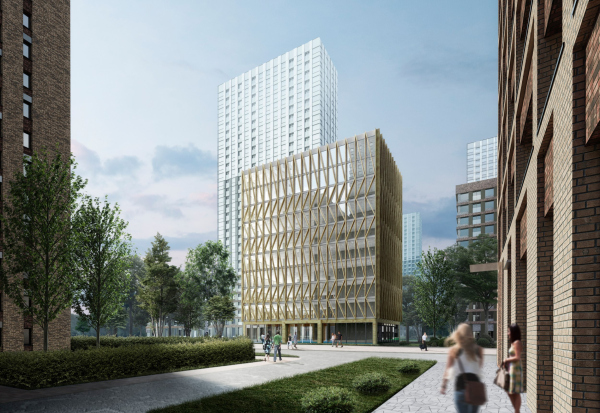 The Balance complex. The multifunctional buildingCopyright: © Ginzburg Architects The multifunctional building. A cross-section view. The Balance complexCopyright: © Ginzburg Architects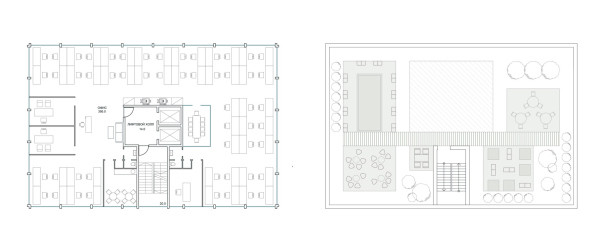 The multifunctional building, the office part. The Balance complex.Copyright: © Ginzburg ArchitectsThe building near Ryazansky Prospekt, scheduled for the last phase of construction, develops the idea, also reflected in the school buildings, of the manifestation of the functions in the image solution: the architects have put together three volumes vertically: a long block of shopping center with a cantilevered “TV”, office “middle” and the “head” packed with apartments. According to the architects, they originally envisioned a tower at this location, but then decided that the horizontal layout would respond better to the proximity of the avenue car flows, would be better read by the eye in traffic and will be more visible, and ultimately will allow them to lay an emphasis on the presence of the mall. 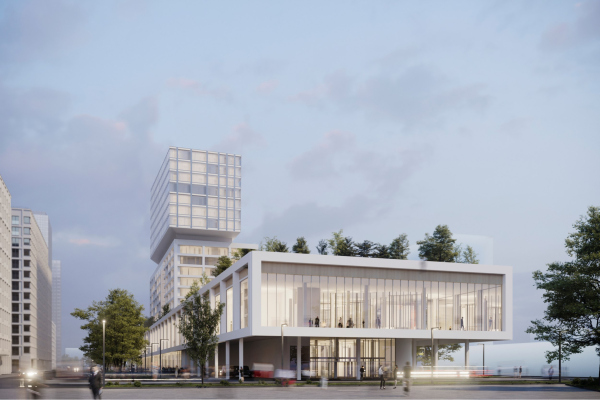 The Balance complex. The multifunctional shopping mallCopyright: © Ginzburg Architects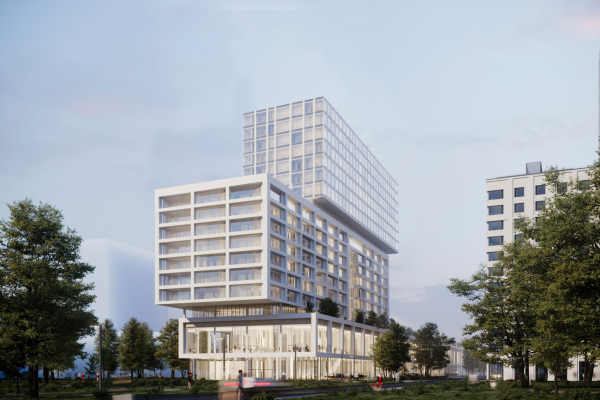 The Balance complex. The multifunctional shopping mallCopyright: © Ginzburg Architects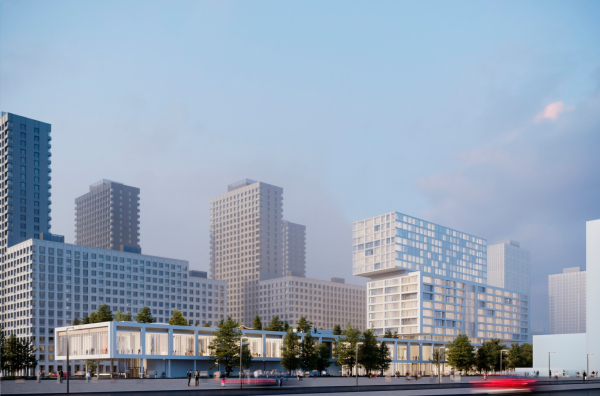 The Balance complex. The multifunctional shopping mallCopyright: © Ginzburg Architects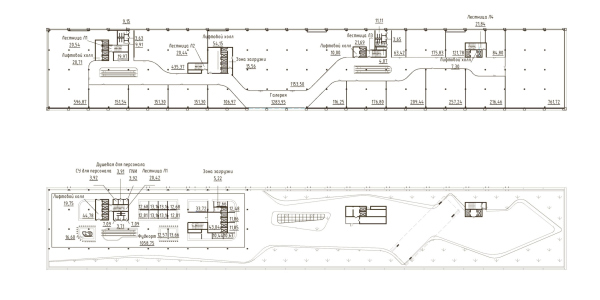 The multifunctional building, plans of the shopping mall. The Balance complexCopyright: © Ginzburg Architects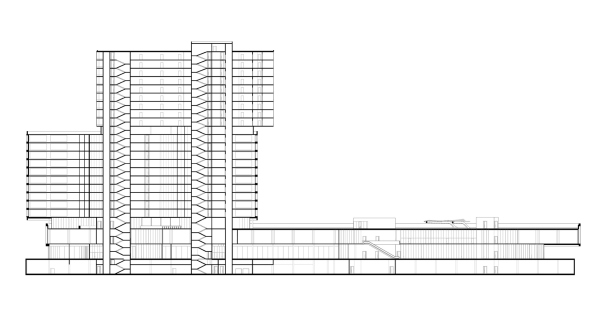 The multifunctional building. A longitudinal section view. The Balance complexCopyright: © Ginzburg ArchitectsThe project, with its five phases and five hundred thousand square meters of total area, fits well into the Moscow trend of the last 10 years: public space organization with the intersection of the city boulevards, first floor stores, highly developed infrastructure, a certain percentage of office space in the neighborhood, and at the same time minimized space for apartments, combined with accessibility of urban spaces. This set can be recognized as an established standard, it responds to the sum of the requirements of both the city and the market. The architects’ ultimate goal in this case is to find a reasonable balance between all the constituent parts of the task, both functional, planning, and figurative. It is as if the residential complex Balance responds to this goal not only with its name. It is built on a laconic, avoiding the excesses but at the same time lively enough and diverse, combination of materials, for each of which the authors find the appropriate way of use, balancing at the same time, the other. And subordinating a simple form, reflecting the function and at the same time recognizable – reducible to the sign/logo. It is not without reason that the authors presented each component part of the complex, each building with a logo sign, which can serve as the basis for the now-popular branding of architecture. The “logos” of the buildings. The Balance complex.Copyright: © Ginzburg Architects |
|
